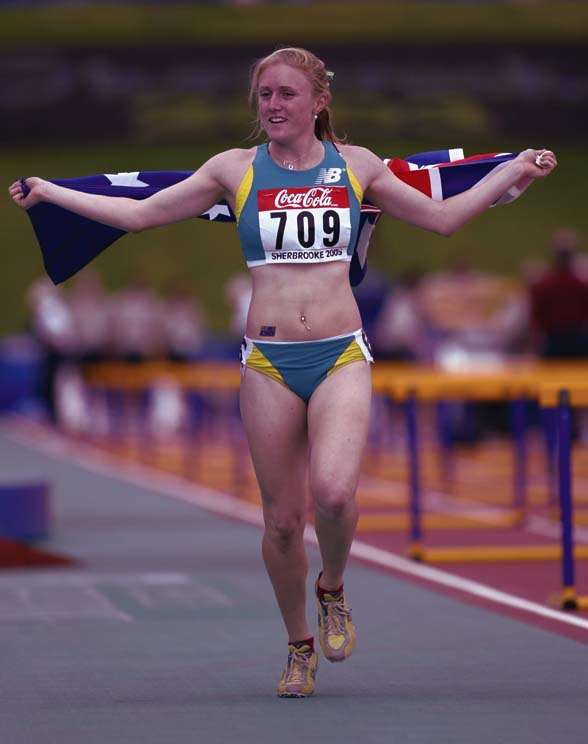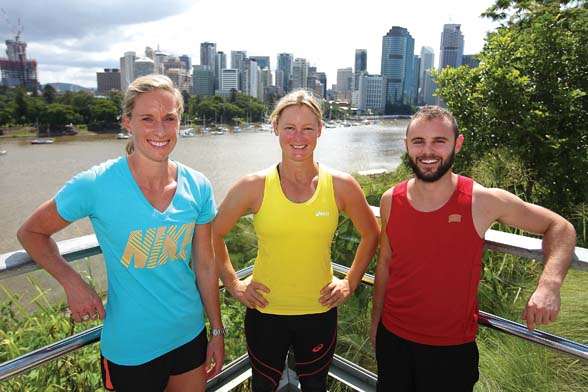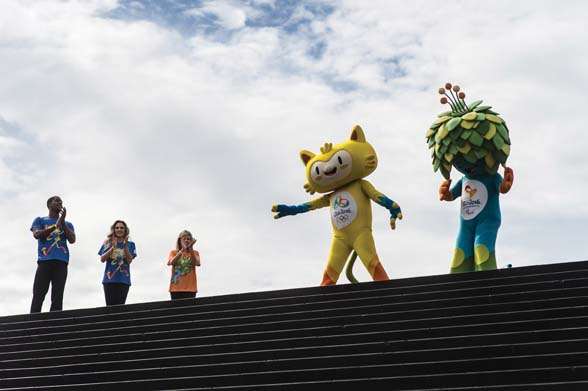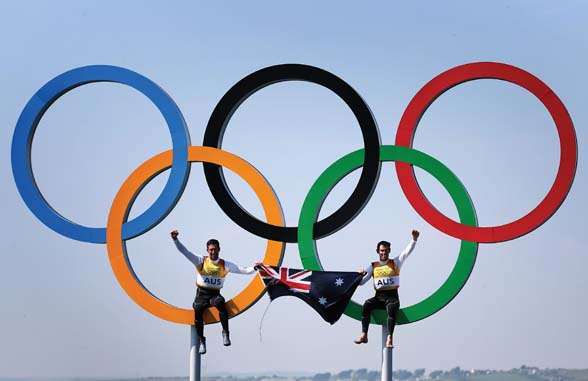We know tomorrow's champions are out there, but where?
Apparently, they're out there: the next and best generation of Australian Olympic athletes we've ever yet seen. But as the countdown to Rio 2016 begins, and with our top athletes and swimming teams heading to their vital World Championships this month, there's just one little problem: we've still got to find 'em.
She was a voice on the radio, a couple of years back, when the shock, fear and dread of Australia finishing – gulp! – tenth at the London 2012 Olympic Games was still fresh and supposedly character-deforming in our collective national psyche.
She was out of the city somewhere, in one of those large rural bases that dot the country, and she had a purpose. It was a sports talent identification clinic for teenagers, and the woman, a national sports executive, was on a recruiting mission. She was a big game hunter, a big Games hunter. I never got her name, but I still remember her message.
“We’re not looking for athletes here today,” she said, dismissing the thought. “We’re looking for gold medallists.”
And so it begins. Anew. Again. The great merry-go-round that is the magnetic pull, the headline draw, the funding banshee cry of Australia’s obsessional pursuit of Olympic medals.
Since London, a line in the sand has been drawn, an attitude of targeted excellence established, as represented by my radio muse. It is this: national policy decrees Australia must rise again to be a top five Olympic nation, preferably as soon as the Rio 2016 Games, which begins less than a year from now.
“It’s always good when you’ve got a goal, a target, and it adds focus if it’s something that you’ve achieved before,” says Simon Hollingsworth, chief executive officer of the Australian Sports Commission (ASC), the country’s peak body for sport. “Next year to make top five [in Rio] will be very, very difficult, but we want to know we are making headway before Tokyo [host of the 2020 Olympic Games].”
Of all the statistics in sport, none rankles or regales Australia quite like the quadrennial Olympic Summer Games medal tally. And none, significantly, has greater impact on the broad public-funded sports industry so intrinsically linked to this random-rich reference point of excellence. Results determined by the fractions of a second or the vagaries of wind direction can create the framework for budget decisions concerning tens of millions of dollars – a curiosity made even more intriguing by the fact so few people can ever correctly recall just how many medals were won at past Games.
For the naysayers and the doomsdayers, we are riding out a Games doldrums. Australia’s past four years can be quickly abbreviated to this: our worst Summer Olympic Games performance at London (35 medals, including seven gold) since Barcelona 1992; our first Winter Olympic Games since 1998 in which we didn’t return with a gold medal; and our first Commonwealth Games in which we didn’t lead the medal table since Edinburgh 1986.
Reason to worry? Well, yes, especially if, like Hollingsworth, you’re employed and entrusted with developing and defining Australia’s sporting talent and identity. Which is why the minds have been churning, the wheels turning, in boardrooms and think tanks and elite training centres around the country.
And, since London 2012, a quiet revolution has taken place, one which has transformed the funding streams and elite performance benchmarks and pathways in this country. This revolution has not been televised; it has hardly even been advertised, but its impact both immediate and long-term will directly define the next decade of Australia’s involvement in major Games events.
Most remarkable of all, this mountain of money, management, policy and bold intentions is underpinned by one unchallenged, upbeat conviction: that there are young men and women around Australia with the talent, the motivation and the character to thrive as elite athletes, that they can be located and their skills nurtured and developed in a high performance environment, and after years of training they can prove themselves better than anyone else on the planet. Forget mining: it’s sports where this country is most reliant on its natural resources for future success.
“My firm belief is physical talent exists just about everywhere,” says Australian Institute of Sport director Matt Favier. “Igniting that talent and activating it ... that’s the challenge for every sport.”
 London came calling for Australia's Olympians in 2012 ... and sent them home heart-broken. (Photo by Getty Images)
London came calling for Australia's Olympians in 2012 ... and sent them home heart-broken. (Photo by Getty Images)The Winning Edge
Does Australia still have its winning edge? For now, we can at least be sure we have Winning Edge, the most comprehensive strategic and administrative overhaul of Australia’s elite sport governance since the 1970s.
Launched in November 2012, Winning Edge is now the policy platform and mission statement that provides an integrated, strategic approach for moving Australia from “world class to world best”, to steal from its own promotional material.
Before it could begin such a Sisyphean task, the architects of Winning Edge first had to kill off a predecessor which had also advocated a radical shift in Aussie sports funding: the Crawford Report. Released in 2009, this report glumly, albeit sagely, floated the idea that Australia’s medal ambitions may need to be checked, with participation in sport a priority over success in elite sport. Media gave the recommendations a beating from which the report never recovered.
The Crawford Report didn’t get the chance to tap out. It got thumped from behind with a brick. At the launch of Winning Edge, at the spiritual home of Australian sport, the Melbourne Cricket Ground, ASC chairman John Wylie said, “The Crawford Report into sport a few years ago advocated a lowering of expectations. We reject that notion.”
Wylie then went on to define the national targets as outlined in Winning Edge: “Top five in the Olympic Games and retaining our top five position in the Paralympic Games; 20 or more world champions every year; number one nation in the Commonwealth Games; and a top 15 finish in the Winter Olympic and Paralympic Games.”
The motivation for all this was, of course, London 2012. It marked the end of Australia’s historic hat-trick of golden Games: Sydney 2000 (58 medals, including 16 gold, fourth on the medal table), Athens 2004 (50 medals, 17 gold, fourth) and Beijing (46 medals, 14 gold, sixth).
As Australia fell to tenth in London, fans gritted their teeth firstly at the success of arch-rival Great Britain (65 medals, including 29 gold medals, behind only the United States and China), and then later as the tales and official reports of the antics, immaturity and infighting of some members of Australia’s London 2012 team, most notably within the swimming and athletics squads, came to light. (See Twin Towers.)
Hollingsworth is quick not to disregard the achievements of Aussie athletes at London 2012. “If there was a disappointment in results, it lay in the reference points of history,” he says.
“But [London 2012] also gave us the impetus to change. If not for London, the feeling may have been to just keep on doing what we were doing as opposed to initiating a complete overhaul of the system, which is what we’ve done with Winning Edge.”
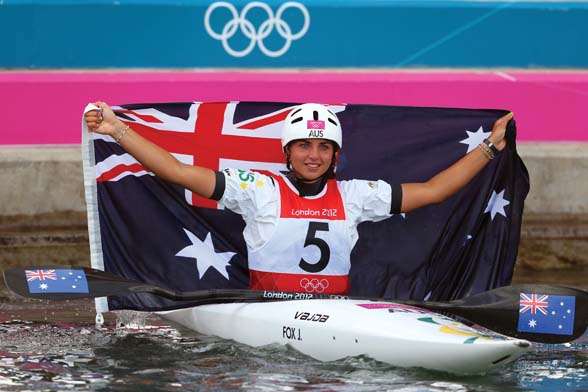 Jessica Fox is the offspring of foreign-born parents who both won world championships in her sport. (Photo by Getty Images)
Jessica Fox is the offspring of foreign-born parents who both won world championships in her sport. (Photo by Getty Images)Change At The top
The changes brought about by Winning Edge have been from the top down, impacting the structure of the ASC and, most notably, the role and responsibilities of its pinnacle operating division, the AIS. For historians, it appears a meeting of providence and precedence: the AIS was established after Australia’s Olympic nadir at the Montreal 1976 Games when we failed to win a gold medal. More than 35 years later, results at London have proved the tipping point for a radical overhaul.
Favier, the head of the AIS, took up his post in March 2012, less than six months after Hollingsworth had started as CEO of the ASC. Both are former international track athletes for Australia, and after diverse professional careers here and abroad, they share a common purpose of reviving Australia’s sagging sporting spirits.
Favier, returning to Australia from working for the billion-dollar juggernaut that was UK Sport, the “No Compromise” body that powered the Team GB Olympic campaign, quickly recognised the need for a strategic shift.
“I did not get a sense when I came back [to Australia] that there was an organisation that had a focused responsibility for driving, supporting and giving full-time attention to the delivery of the resources and services required to achieve international performances,” he said. “We needed to make changes as to how high performance sport was delivered in Australia. The implementation of Winning Edge to the AIS means we have redefined, and continue to redefine, ourselves as a strategic high performance sports agency.”
The AIS no longer has a scholarship program for athletes. It no longer employs coaches. Such responsibilities now rest with national sport organisations (NSOs). Instead, the AIS sits atop a strategic tier system of athlete support, with the NSOs and state-based institutes and academies all buying into this integrated model. Importantly, there is also buy-in to this system from the Australian Olympic Committee. The AIS is now also responsible for overseeing the investment to the 37 sports aligned with Winning Edge – a sum of $110 million for 2014/15 alone. (See The Price Of Gold.)
“Don’t forget we had 32 years of history of working in one way [at the AIS], and so to stop doing something that had been so successful previously, we were making a significant shift in the way the organisation operated,” says Favier.
Adds Hollingsworth: “The task was to redefine not just the role of AIS, but how the sector operates as a collective. What I’m most proud about is we’ve given the sector clarity about what we are trying to achieve.”
In Talent We Trust
One priority of Winning Edge remains integral: investing in a “renewed focus on unearthing and nurturing Australian talent”. Once, finding such sporting talent was a backyard industry – literally. Kids would play sports, some would prove better than others, and if luck and/or connections worked out, they’d rise to be Australian representatives.
Nostalgia for such simple times is tinged the colour of half-time oranges. Much is now made that Australia has a relatively small population (23 million and counting) with which to take on the world. In short, we need every fit, healthy and willing young resource we can get.
And where do we find them? For all the science, the first and best breeding ground remains Australia’s entrenched leisure and junior sporting club scene – the type of volunteer-rich/parent-engaged community organisations Inside Sport is celebrating with its new awards program, The Clubbies.
Favier recalls watching a young Sally Pearson first learning her craft at Queensland junior athletics meets. Jessica Fox, the dazzling canoe/kayak-slalom dual world champion and 2012 Olympic silver medallist who deserves to be a break-out star of Rio 2016, is the offspring of foreign-born parents who both won world championships in her sport. Dual Olympic gold medallist Emily Seebohm joined a swimming club at age ten and found she couldn’t stay away from the rush of competition. Her team-mates, siblings Cate and Bronte Campbell, were drawn to the local swimming club shortly after arriving in Australia from Malawi as primary-schoolers.
Growing up on the Gold Coast, reigning Olympic and world champion 470 sailor Mathew Belcher’s sporting destiny was found at the end of a tow rope. “Mum and Dad were both boaties and each weekend they’d take me and my brother [Daniel, with whom Mat won the 420 world championships in 2000 as a teenager] out on the water. We used to tow a Sabot, which is a really small wooden sailing dinghy. We’d jump in it just for some fun and to keep us entertained.”
Belcher, now 32, recalls a steady progression as his interest and skills in the sport developed. “I came through the ranks, then got involved with our school sailing [program], then continued to state-level, then to national level, and then on through to becoming involved in the Olympic squad.” But that’s a long, tough road Belcher is describing so modestly: by the time he was selected for his first Olympic team in 2012, he had won multiple world titles in his 470 class.
It should be remembered that it was Belcher and his sailing team-mates that “saved” Australia’s London 2012 campaign, winning three of the nation’s seven gold medals – Belcher and Malcolm Page in the men’s 470, Tom Slingsby in the Laser, and Nathan Outteridge and Iain Jensen in the men’s 49er. The success has provided for a spike in high performance funding for sailing. Belcher also notes with pride that the trickle-down effect has been greater exposure for his sport and improved opportunities for juniors to access higher levels of competition.
But Australia’s sporting future cannot be left solely in destiny’s hands. Winning Edge has also instituted an annual “AIS Sports Draft”, in which athletes aged 15 to 26 are physically tested to determine whether they have the potential to transfer their skills to new sports and disciplines. In its third year, the 2015 draft has ten stops across Australia in August and September, with the trials identifying athletes for track cycling, canoe/kayak, women’s rugby sevens, boxing, judo and taekwondo.
In 2013 and 2014, more than 350 athletes were tested at the draft, with 35 being invited to join training programs. Many of these invitees – from backgrounds as diverse as Aussie rules and basketball to acrobatics and dragon boat racing – have found themselves at “combat sport” training camps for Olympic pursuits such as judo and taekwondo. The ranks of women getting involved is especially pleasing to administrators like Hollingsworth and Favier.
One Olympian well-placed to understand the challenges which await these intrepid transferees is Naomi Flood. A brilliant surf lifesaver, Flood enjoyed international and national success before claiming the biggest prize in her sport, the Ironwoman series crown, in 2009. Soon after, at age 23, Flood made the brave choice to leave her first sport to pursue her childhood dream of competing at the Olympic Games.
Flood soon found the waves and the havoc of surf events replaced by the flatwater and technical demands of kayak sprint racing, aided by the interest and advice of Olympians including Katrin Borchert. An accomplished surf ski paddler, Flood effectively had to learn a new craft – and save herself from sinking. “For a long time I had tried to figure out how I could compete at the Olympics,” says Flood. “The paddling seemed a natural fit because of my surf ski background.
“Then I jumped in a kayak and it was terrible. I was hopeless. I couldn’t deal with it. I hated it. I could hardly stay out of the water. I had to learn a whole new technique, a new tactical way to approach paddling. There’s no easy or quick way to do that.”
Beyond the physical challenges, Flood also found herself mentally exhausted: “I was 23, and that is old to pick up a completely new skill set in a sport. I knew I had fallen so far, from being at the top of the pile in one sport to the bottom of the pile in kayaking. But the dream of going to the Olympics was still burning inside of me, so I got my head around it and was lucky to find great support for what I was doing.”
Flood raced in the women’s K2 500m with Lyndsay Fogarty at London 2012, placing 12th overall. For Rio, her focus is qualifying in the women’s K4 500m with fellow 2012 Olympians Jo Bridgen-Jones and Alana Nicholls, and newcomer Bernadette Wallace, the younger sister of Beijing 2008 gold medallist Ken Wallace. A medal would cap an incredible journey for Flood.
Australia’s Rio team will surely include other inspiring examples of athletes who have taken up new pursuits, such as 2012 Olympic medallists Kim Crow(hurdling to rowing) and Rohan Dennis (swimming to cycling). By Tokyo 2020, the Winning Edge initiatives may have assisted other young Australians to reach the Games in disciplines far removed from their first sporting loves.
Onwards And Upwards
At the ASC, Hollingsworth, a dual Olympian in the ’90s, never loses sight of the sweat, toil, commitment and potential heartache that is the lot of the aspiring elite athlete. The medal dreams of a nation rely on their efforts. The successes we all want to share; anything less we too comfortably leave well alone.
“Every athlete at the international level is training hard, doing the little things they need to do to continue to improve,” he says. “And still very few make it to the top. And there are even fewer who get to stay at the top and enjoy sustained success.
“The odds of achieving as an elite athlete are quite low. Can you imagine the job ad? ‘Please reply: low-paying job, long hours, lots of physical pain, occasional rewards [maybe], chance of setting yourself up financially for life: low.’”
Roll up, young Australians. Roll up.
REBUILDING THE TWIN TOWERS
For swimming and athletics locally, the time since London 2012 has been all about restoring internal order – and public confidence – in its elite teams and administrations. Both leading Olympic sports have lived through far-reaching internal reviews, and the associated negative publicity generated by the actions of a handful of athletes and officials.
Now, as supporters, we’re about to find out how both sports are tracking before Rio at their respective 2015 world championships. Our swimmers (and divers, water polo players and synchro swimmers) head to Kazan, Russia, for the FINA World Championships from July 24 to August 9. The IAAF World Championships has Beijing’s famous Bird’s Nest stadium as its venue from August 22-30.
Australian swimming’s bright and shining status was first tarnished by a disappointing London 2012 campaign, the only gold coming in the women’s 4x100m freestyle relay, marking the first Games since Montreal 1976 in which Australia did not have an individual swimming gold medallist. It was then trashed as the stupid, selfish late-night escapades of the men’s “Stilnox Six” before London 2012 and other negative storylines played out in the popular press.
In response, swimming appointed its first foreign head coach, Dutchman Jacco Verhaeren, in January 2014. Verhaeren, in his own words, brings “fresh eyes” to a program at times stunted by its own traditions and past glories. He enjoyed the relatively soft landing of the Glasgow 2014 Commonwealth Games, where both the men and women excelled.
For swimmers, the changes since London 2012 have been significant – and warmly welcomed. Emily Seebohm, an Olympic relay gold medallist in Beijing and London and six-time world championships medallist, says there has been “massive improvement” in the elite team environment.
“The culture now is really, really good,” she says. “It was a lot about working together more – swimming is so individual, it is not [naturally] a team sport at all. It has been about moving our minds away from being individuals and thinking of it more as a team sport and becoming more team-involved to best support everyone.”
In Kazan, Australia must do without the significant talents of the injured James Magnussen, recovering from shoulder surgery and thus unable to defend his 100m freestyle crown, Brittany Elmslie and Kylie Palmer, the last withdrawing to prepare a challenge to a recently announced 2013 positive test for a banned diuretic.
Seebohm, still just 23, will swim her usually busy program, with the 100m backstroke and relays a priority. Watch also for the continuing rise of men’s freestyle sprinter Cam McEvoy, sibling stars David and Emma McKeon, and the Campbells, reigning 100m world champion Cate and sister Bronte. Australia won three gold and ten silver swimming medals at the 2013 Worlds.
When athletics last loomed large in our national press, it was at Glasgow 2014 and then-head coach Eric Hollingsworth was being bounced out of Scotland after his extraordinary actions of personally releasing a press statement criticising hurdles queen Sally Pearson as she prepared to defend her Commonwealth title.
To no one’s surprise, Englishman Hollingsworth was removed from the post soon after. His successor, Craig Hilliard, brings with him more than 30 years of experience as a senior coach, much of it spent with the Australian Institute of Sport. He appears well placed to not only steer athletics back on track, but also to ensure his sport reaps maximum benefit from the initiatives of Winning Edge and its future-focused programs.
Appointed in April, Hilliard’s strength is his versatility and knowledge across athletics’ broad spectrum of events: he has coached champions including hurdler Jana Pittman, long jumper Jai Taurima and walker Nathan Deakes. He’s also called on relationships built up after a lifetime in the sport to repair some broken fences. Meeting and engaging with athletes and coaches has been a priority in his first few months in charge.
“We’re a diverse sport, there’s no question about that,” says Hilliard. “As a team, we may get together realistically only once a year apart from national championships, and then that’s for a major event, a world championships or an Olympic or Commonwealth Games. Our athletes have such diverse competition plans and training plans and their programs are so varied, depending on their personal needs, talent level and physical preparation.”
In Beijing, Hilliard will be without team talisman and leader Pearson, the 2012 Olympic champion tumbling out of the Worlds after injuring her wrist in a race fall in Rome in June. In her absence, javelin star Kim Mickle, a silver medallist at the 2013 Worlds, three-time Olympic walking medallist Jared Tallent and former world discus champion Dani Samuels will spearhead a team that includes emerging stars such as high jump’s Eleanor Patterson, steeplechaser Madeline Heiner and walker Dane Bird-Smith.
While Hilliard has retained Pearson as team captain, he’s appointed four “deputies” for Beijing: Mickle, walker Chris Erickson, pole vaulter Alana Boyd and 400m hurdler Lauren Wells. Hilliard expects these veterans to “give strength, advice and leadership to the younger athletes”. The competition will be hot in Beijing, but the road to Rio already seems to be better plotted than it was just six months ago.
Related Articles

Feature Story: Moving the Needle

The Aussies at The Open


